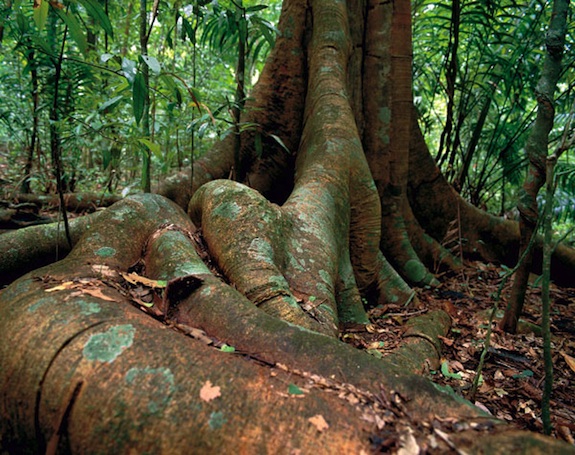Warmer Temperatures Speed Tropical Plant Growth
New research challenges key assumptions about plant growth at increased temperatures
![]()

Trees in the rainforest experience elevated nighttime temperatures and new research shows that may mean increased growth as well. Photo courtesy of the Smithsonian Tropical Research Institute
As the world warms, certain parts warm faster than others and it’s there that researchers are finding climate change clues that may alter our understanding of plant growth in general.
While average global temperatures have been rising at roughly 0.2 degrees Celsius per decade since 1975, the tropics have been warming slightly faster, at a rate of 0.26 degrees per decade. And in tropical Panama at night, things are getting even hotter. Researchers Alexander Cheesman and Klaus Winter found an increase of 1.5 degrees in average nighttime temperature over the past four decades. Testing what that jump might mean for tropical plants, the pair took fig and balsa tree seedlings and measured their growth at a range of increasing nighttime temperatures. What they found runs counter to the conventional climate change wisdom: the plants put on more than twice as much weight as the seedlings kept at normal conditions.
Traditional thinking, says Cheesman, who recently completed his post-doc fellowship with the Smithsonian Tropical Research Institute, says that during the day, plants undergo photosynthesis, capturing carbon and at night, they undergo respiration, losing carbon. The difference between the two governs the growth of the plant. Warmer temperatures increase respiration and thus, reduce growth, according to the model. But Cheesman says his research seriously challenges that rather simplistic understanding of respiration.
“It’s not that it’s just carbon loss because in losing that carbon it’s also doing all these other things: it’s producing ATP (adenosine triphosphate), it’s producing metabolic precursors that can be then used in building new cells.” Building on research that supports the productive purposes of respiration, Cheesman and Winter were able to show that rising temperatures did not increase respiration and thus slow growth, as expected, but rather increased both.
Using controlled-environment chambers and open-top chambers, the pair tested the growth of two neotropical tree species. Seedlings were maintained under constant daytime temperatures, matching those of central Panama, and exposed to elevated nighttime temperatures ranging from22 degrees to 31 degrees Celsius, or 72 degrees to 88 degrees Fahrenheit.
The latter group saw growth rates more than twice that of the first group. Cheesman thinks it’s likely, however, that trees with accelerated growth would stop growing once they reached a certain size, meaning there would not necessarily be larger trees in the forest. “You have plants achieving the same overall growth but at a faster rate,” explains Cheesman, “so it could well be that the turnover of forests becomes faster. ”
“There’s been a lot of this work done in agricultural systems with perennial and annual crop plants and similar things have been shown there,” but he says, “with trees it’s just fundamentally harder to run an experiment for the whole generation, from the seedling up to producing seedlings itself.”
Nonetheless, Cheesman thinks there’s a strong possibility increased respiration might mean shorter generations, which would have a whole host of implications for the plants’ ecological systems.
The faster rate may also mean a weaker plant. Independent from this study, another researcher, Whitman Miller of the Smithsonian Environmental Research Center in Edgewater, Maryland, working with seagrass found ”that elevated CO2 resulted in faster growth (a good thing), but accompanying reductions in protective chemical compounds (a bad thing).”
Cheesman says the finding lines up with his own experience studying tropical species.
“We see something similar in seedlings,” he says. “Increased nighttime temperature can result in increased shoot height and an increase in the internode length between leaves and so that has implications for things like structural integrity and potentially water movement in mature trees.” Weaker structures may make plants more susceptible to parasites or fungus, something Miller also notes in his work.
Though he believes his paper does signal a need to rethink models of photosynthesis-driven growth, Cheesman acknowledges the study’s limitations and the many unknowns.
“There are very important caveats in so much as, increasing nighttime temperatures will result in very different precipitation patterns and water availability which may have very profound implications on tree growth itself,” he says, citing one such outstanding question. “You’ve got a direct influence of the temperature and then a lot of indirect influences on all sorts of other things.”
He hopes his future research can expand what he’s started with Winter. “I’m interested in how temperature interacts with other processes, so not just photosynthesis and respiration but things like meristematic activity, leaf development, all of these processes and how they all tie into together into an integrated response to temperature.”
/https://tf-cmsv2-smithsonianmag-media.s3.amazonaws.com/accounts/headshot/Leah-Binkovitz-240.jpg)
/https://tf-cmsv2-smithsonianmag-media.s3.amazonaws.com/accounts/headshot/Leah-Binkovitz-240.jpg)